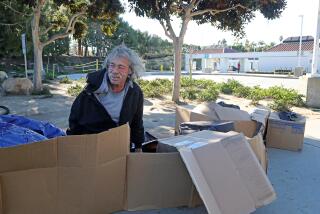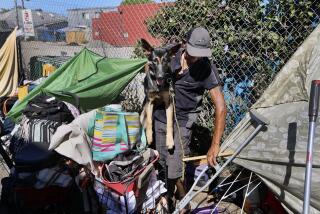Ventura Takes Legal Way Out on Skateboard Issue
As a way of protecting the city from lawsuits should someone get hurt, the Ventura City Council on Monday night decided to post warning signs at its skateboard park that require visitors to wear helmets and elbow and knee pads.
But believing most youths would avoid the new park if forced to wear protective gear, city officials promised the new law would not be actively enforced. The council voted 6 to 1 to approve the ordinance, with Deputy Mayor Ray Di Guilio dissenting.
The warning signs are designed mainly to shield the city from injury claims, City Manager Donna Landeros said.
Under a 1997 state law, cities can protect themselves from liability claims at skateboard parks from those 14 and older if they pass an ordinance and post signs requiring skaters to wear protective gear.
“This is not a safety issue,” Landeros said before the meeting. “This is something attorneys came up with to prevent people from suing.”
At least one Ventura resident disagrees with the nonenforcement policy.
“What stands out is not the city’s concern for the safety and well-being of its youngsters, but rather its focus on merely covering its tail against liability should a child be injured using the skateboard parks,” resident Ursula Britton wrote in a recent letter to Mayor James Friedman. “So the solution apparently is to adopt the required ordinance, post the required signs and to hell with enforcement.”
Landeros said the problem rests with the state law that requires cities to post warning signs to avoid lawsuits. She said her staff will lobby state legislators to abolish all municipal liability for such facilities.
“If we forced them to wear protective gear, they would go back to skating on the streets and private property,” Landeros continued. “It’s odd to have a state law that actually backfires on the objective--to get the kids off the streets and onto a safe skateboard park.”
But Friedman said the safety of skateboarders was the most important consideration.
“What it boils down to is: Would we rather have kids skateboarding in the streets, where they could be seriously injured, or skate in the parks where there are no cars?” he said. “The safety of the kids is my biggest concern.”
On Monday night, the council passed an emergency ordinance that makes it unlawful for someone to use the city’s skateboard park without safety equipment. The law also gives staff members the authority to post the signs at its newly opened skateboard park at Westpark in the Ventura Avenue neighborhood.
It gives the green light to similar signs at skateboard parks scheduled to open at Pacific High School in midtown Ventura and at Hobart Park in east Ventura by summer’s end. Installing signs at the three parks is expected to cost a total of $1,000.
By posting the signs, the city will not be mandated to provide supervision at the parks. Landeros said the city could not afford the approximately $150,000 a year it would cost to hire security guards to patrol the parks.
“If we had to pay three staff members to patrol the parks, we couldn’t have the parks,” Landeros said.
Britton, who lives near Pacific High, urged the city to not only supervise the parks, but to provide signs, fencing and locks at the facilities.
“Perhaps the money for the lobbyist would be better spent on skateboard park supervision,” Britton wrote.
Di Guilio, who questioned the council approving an ordinance it didn’t plan to enforce, said opponents of the skateboard parks would swamp the police with complaints about teens violating the new law.
In Camarillo, similar warning signs will be posted at a skateboard park scheduled to open by the end of the month, said John Williamson, general manager of the Pleasant Valley Recreation and Park District.
District officials have no plans to regularly patrol that park, Williamson said.
“As long as we post the signs, people realize what the risk is, and we’ve done our job,” he said.
In Thousand Oaks, staffers at the Conejo Recreation and Park District monitor the activity at the three portable skateboard parks in the area. Skateboarders are required to wear protective gear and must sign waivers each year releasing the city from liability should an injury occur.
Since October, when portable skateboard ramps were placed at the Thousand Oaks Community Center, the number of skaters using the park has decreased from about 25 each day to 15, said Lori Olbrich, the center’s recreation coordinator.
“I don’t think it’s because we make them wear helmets,” Olbrich said. “They’re teenagers, they want to skate anywhere. They want to to able to use the curbs and weird areas in the community. That’s the nature of the sport.”
More to Read
Sign up for Essential California
The most important California stories and recommendations in your inbox every morning.
You may occasionally receive promotional content from the Los Angeles Times.










